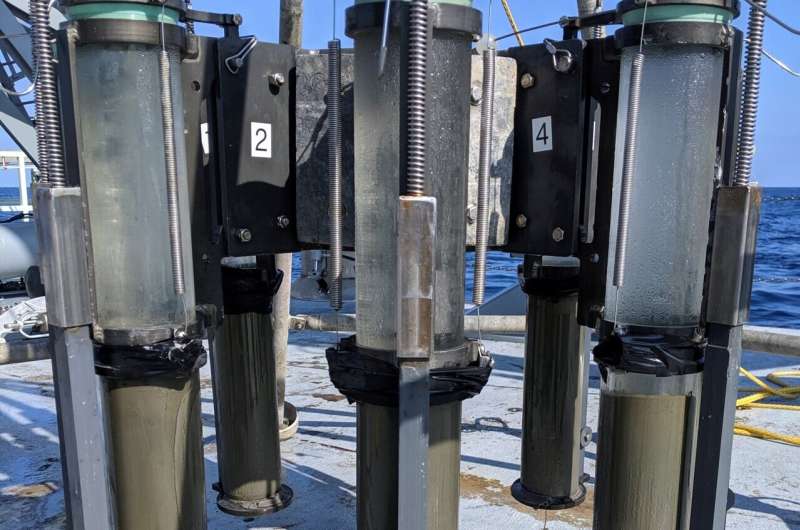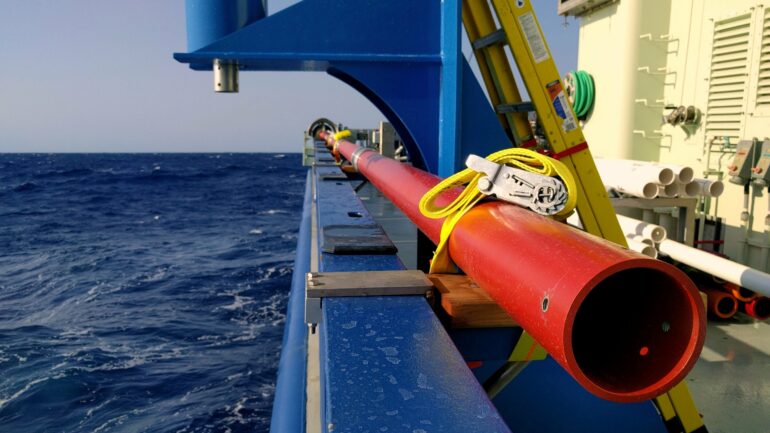New evidence of changes to the Gulf Stream during the last ice age could indicate additional sensitivity to future climatic changes, finds a new study led by UCL researchers.
The research, published in Nature, found that during the last ice age about 20,000 years ago, the Gulf Stream was stronger than today because of more powerful winds across the subtropical North Atlantic.
This could mean that if climate change causes a reduction in subtropical winds in the future, as initial research is beginning to indicate, the Gulf Stream could also weaken. This would limit the amount of tropical heat that reaches Europe, cooling the continent and causing higher sea levels in North America, but the likely size of this potential effect is still unclear.
The Gulf Stream is a surface current that flows up the east coast of the US then crosses the Atlantic to Europe, carrying warm tropical water with it. This warm water releases heat into the atmosphere, warming Europe.
The researchers found that during the last ice age, when ice sheets covered much of the northern hemisphere, stronger winds in the region resulted in a stronger and deeper Gulf Stream. However, despite the stronger Gulf Stream, overall, the planet was still much colder than today.

Close up of multicorer rig on the stern of the R/V Armstrong. Multicorers are used to collect the most recently deposited ~50cm of sediments, which includes the uppermost layer at the water/sediment interface. © Dr. Alice Carter-Champion
Lead author Dr. Jack Wharton (UCL Geography) said, “We found that during the last ice age, the Gulf Stream was much stronger because of stronger winds across the subtropical North Atlantic. As a result, the Gulf Stream was still moving lots of heat northwards, despite the rest of the planet being far colder.
“Our work also highlights the Gulf Stream’s potential sensitivity to future changes in wind patterns. For example, if in the future winds are weaker, as shown in a recent study using climate models, it could mean a weaker Gulf Stream and a cooler Europe.”
The Gulf Stream is also part of the vast Atlantic Meridional Overturning Circulation (AMOC), which is driven by both deep water formation in the subpolar North Atlantic, where cooling causes surface waters to become dense and sink, as well as winds.
Scientists have previously raised concerns about how climate change could weaken the AMOC as melting glacial water pouring off Greenland could disrupt deepwater formation, preventing warm tropical water from reaching Europe and thus cooling the continent.
Together, the combined effect of weakening winds and reduced deep water formation could significantly weaken the Gulf Stream. If the AMOC were to collapse—considered an unlikely but possible future scenario—European temperatures would cool by 10 to 15 degrees Celsius, wreaking havoc on continental agriculture and weather patterns, and the decrease in the wind-driven part of the Gulf Stream would further exacerbate this.

Multicorer rig on the stern of the R/V Armstrong. © Dr. Alice Carter-Champion
Co-author Professor Mark Maslin (UCL Geography) said, “It’s not always recognized how much ocean currents are responsible for transferring heat around the planet and shaping our climate. Paradoxically, the warming of the climate could cool down much of Europe by disrupting the AMOC. Our new research adds to this understanding, and shows that the weakening of the winds which drive the Gulf Stream could reduce the circulation of heat, further affecting the continent.”
Though the AMOC and its constituent currents, including the Gulf Stream, is sometimes referred to as a giant conveyer belt, this study highlights the system’s complexity, with each part of the current capable of having its own unique response to climate change.
Co-author Professor David Thornalley (UCL Geography) said, “Rather than the established conveyor belt metaphor, perhaps it is better to think of the AMOC as a series of interconnected loops. There is the subtropical loop—that the Gulf Stream is part of—and a subpolar loop, which carries heat further northwards into the Arctic.
“During the last ice age, our findings show that the subtropical loop was stronger than it is today, whereas the subpolar loop is thought to have been weaker. Therefore, when investigating anthropogenic climate change and the AMOC, we need to consider how these different parts may change and what climate impacts each is associated with.”



